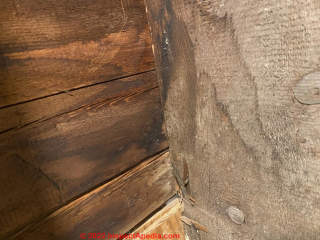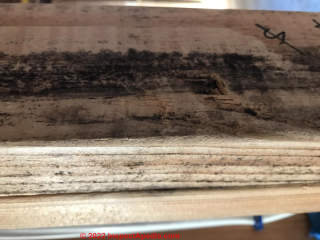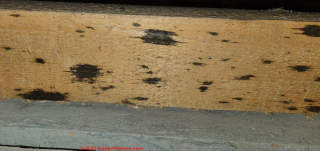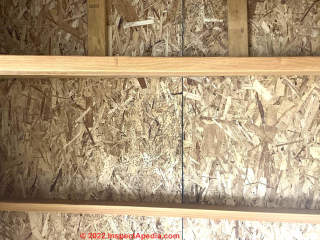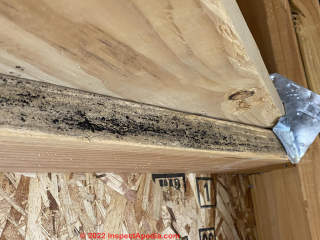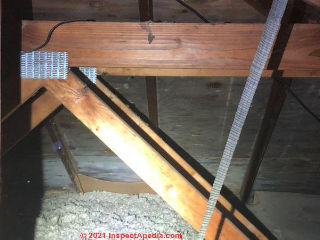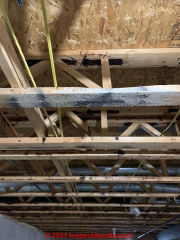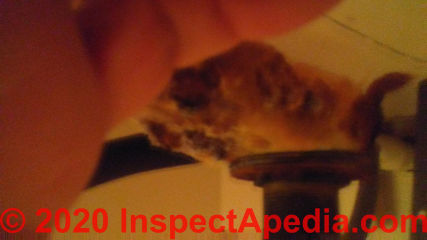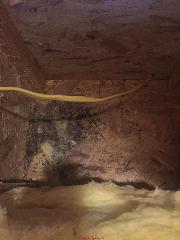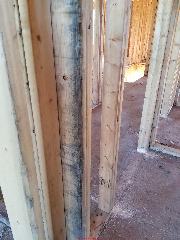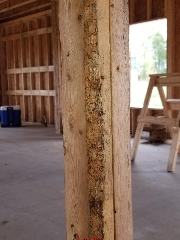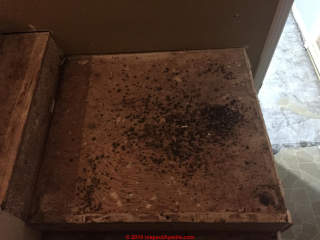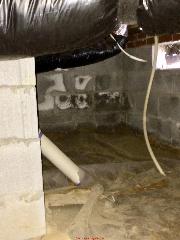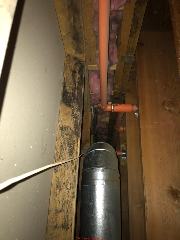 Identify Harmless Black Mold - FAQs
Identify Harmless Black Mold - FAQs
Q&A on recognizing cosmetic black mold
- POST a QUESTION or COMMENT about cosmetic black or dark colored mold in buildings
Q&A about how to recognize harmless black or dark colored indoor mold.
This article series provides both explanation and hotographs of harmless cosmetic black mold on indoor surfaces.
The page top photo of cosmetic black mold on a wall stud was contributed by an InspectApedia.com reader who reports finding this harmless mold in an Arizona home.
InspectAPedia tolerates no conflicts of interest. We have no relationship with advertisers, products, or services discussed at this website.
- Daniel Friedman, Publisher/Editor/Author - See WHO ARE WE?
Questions & Answers about How to Recognize Harmless-Cosmetic Black Mold
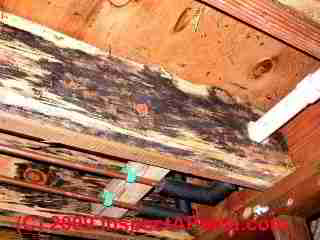 These questions and answers about identifying black mold and harmless or "cosmetic" dark colored mold in buildings or on building materials were posted originally
These questions and answers about identifying black mold and harmless or "cosmetic" dark colored mold in buildings or on building materials were posted originally
at BLACK MOLD, HARMLESS - be sure to see the advice and photos given there.
[Click to enlarge any image]
Question: home inspector found black mold that is just "microbial"
(Mar 25, 2015) Liz said:
We had a home inspection that says that the attic rafters appear to have cosmetic black mold but the home inspector states that is is microbial.
Can you suggest what we should do from here?
Reply: mold is not a microbial
Wow what a bunch of gobbledygook language. "it's just microbial" - what the heck. All mold is microbial. Lots of things are microbial. Balderdash.
Microbial - properly used - is defined as related to or characteristic of a microorganism, especially a bacterium causing disease or fermentation. Calling mold microbial is an effort to please the seller and realtor of the home you're buying - and is unnecessary since nobody should be in a panic even if there is some mold to clean up.
But let's be clear: Mold is not a bacterium.
Because of the conditions that produce mold growth indoors (dampness or leaks), mold is however often found where there are also microbial contaminants and those can cause trouble ranging from allergic responses to asthma attacks to more-serious infections.
While usually we need to examine a surface tape sample of mold growth to identify it in the laboratory, there are a few instances in which we can put the question to bed with some simple visual observation and common sense.
Determine if the "black mold" seen has actually grown on the building surfaces since original construction, which means it should be examined further, its cause corrected, and if it's significant in area, professionally removed.
In the article BLACK MOLD, HARMLESS take another look at the paragraph and photo at the heading
Interrupted Mold Growth Confirms No Active Mold Growth on Indoor Framing Lumber
and you'll see how to easily make a determination between cosmetic mold and other indoor mold that deserves more-serious attention.
On 2022-02-08 by Inspectapedia Com Moderator - water stains from prior leaks may warrant further investigation
@Julie,
That in deed looks like water stains from prior leaks.
The amount and type of stain that I can see in the photo to which I attach this comment , if that's all there is, would be in my opinion, trivial. Not really a concern. You might use any household spray cleaner to clean off any surface material and leave the remaining stain alone. Just be sure there's no ongoing leakage.
IF however water has leaked into other building cavities where they are covered by drywall - that would be worth further investigation.
On 2022-02-08 by Julie
I live in a townhouse in NJ and I removed the drywalls ceiling to expose the beams in my bedroom. Initially happy, I found many water stains and black stains.
Now, I have the impression that I just opened a can of worms and whatever it is, it might be dangerous for my kids and myself. What are your thoughts based on this picture? Should I just put back the drywalls?
On 2021-12-30 by Inspectapedia Com Moderator
@Julie,
You'll want to read the article above and also see COSMETIC MOLD, RECOGNIZE https://inspectapedia.com/mold/Cosmetic_Mold.php
Check the points where that framing lumber that has black mold growth abuts other lumber and plywood or sheathing: does the mold growth pattern continue onto other surfaces?
On 2021-12-28 by Julie
Hi. We are building a new home, which has already been framed and the roof and exterior walls are on. We live in the valley so we do get rain and it can get humid. Can't remember what the lumber looked like beforehand or when the black mold showed up. Based on your informative article, looks like it's the harmless black mold based on the clues? Seems like there is quite a bit on the lumber. Wondering if we should just leave it and put the interior walls up or clean it off first? Thank you!
On 2021-11-11 by Inspectapedia Com Moderator - do not apply a stain or finish over moldy wood
@Janet,
You definitely do not want to apply a stain or finish over moldy wood. And most molds will show through most stains.
You will essentially be preserving the mold in the wood even if it doesn't continue to grow.
If you don't like the appearance of the wood you need to clean those surfaces thoroughly before staining and finishing them.
Do post a photo so we can see what it looks like
On 2021-11-11 by Janet
My Amish-built cabin just arrived recently and I'm greatly relieved to read this column about what is and is not acceptable discolorations on the wood! That being said, there are some exposed rafter beams in the ceiling that are discolored and unattractive. Yes, they could be painted but I was planning to stain them.
Will this discoloration show thru a stain? or will it disappear/fade once the stain is applied? or should I just plan on a darker stain maybe? Any & all suggestions are greatly appreciated!
On 2021-11-06 by Inspectapedia Com Moderator
@Dragoș,
Take a look at the clues above on this page to distinguish cosmetic mold from other types of mold growth and also look for signs of leaks or moisture in your attic. In any event don't panic.
On 2021-11-06 by Dragoș
I saw this on my attic wooden beams. I got a little panic because I did not know what it is.
On 2021-10-21 inspectapedia.com.moderator
@Amanda,
When you see a joint where the moldy wood touches another wood member that's clean, you know mold isn't growing actively in that location - it came in on the wood.
On 2021-10-21 by Amanda
Hello, I recently purchased this home. The garage is brand new. Today I noticed black dots on the plywood as well as the framing. Please see photos. Is this cosmetic mold?
On 2021-05-30 - by (mod) - "black mold" per se is not the only mold that we need to remove
@Jim,You can use the add image button to post a photo with your comment.
Keep in mind that "black mold" per se is not the only mold that we need to remove and whose cause needs to be fixed in buildings.
There are green, red, orange, yellow, purple, blue, and other colored molds that can be equally harmful.
On 2021-05-30 by Jim
Hi, does this look like black mold? When wiped with a paper towel, some black comes off.
On 2021-05-26 - by (mod) -
@Christal L,that's a reasonable *guess*
Double-check that
- there is no continuation of growth of this mold onto adjoining surfaces such as the wood- or OSB- subfloor overhead
- there is no moisture source such as leaks or water entry - that the crawl space is dry
On 2021-05-26 by Christal L
Wanted to get an opinion of this? It’s only on a few boards under crawl space. Is this consistent with the cosmetic mold?
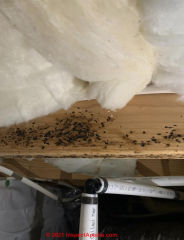
On 2021-04-17 - by (mod) -
@Lauren,Now I can't say with certainty that there is no other mold growing on the wood but just based on what we see in your photo, that looks like the "cosmetic mold" described above on this page;
Take note that at no place do we see continued areas of mold that start on the joist and continue on the plywood subfloor or at other points of wood abutment between different wood members or materials. If that's the case then that mold came in on the lumber.
On 2021-04-17 by Lauren
Does this look like harmful or concerning mold? We have found it on every wood joist running through basement ceiling. It was not here when bought house 2yrs ago. We have two young children, wondering if should worry?

On 2021-04-08 - by (mod) -
I meant to add that when you have more than 30 square feet of contiguous moldy material it needs to be dealt with by a professional.On 2021-04-08 by (mod) - how do we know that it isn't black mold?
@Lauren, I'm sorry if I wasn't sufficiently clear on this point.
Watch out: In questions of danger, health, or clean-up and prevention, makes absolutely no difference what color the mold is.
It is a serious injury to Consumers to make people think that we only need to worry about black colored mold.
There are harmful modes of every color.
There is a single and unusual exception of cosmetic black mold which is very easy to identify by looking at the photos and the explanation on the page above.
I can already tell you from your photo that you do not have harmless cosmetic black mold.
I tried to explain and perhaps you can help me learn how to be more clear, that The color of the mold won't change what you need to do one bit.
On 2021-04-08 by Lauren
I read the article, but how do we know that it isn't black mold? We had a "specialist" come look at it they said it didn't seem to be anywhere put on the sheathing. There are black marks, but for the most part it's fuzzy white. Would you recommend a remediation company to come out?
My husband and I planned on doing this ourselves--respirators and all. What else would you recommend for us? Especially considering it's in a closed space in the attic. It's above the garage, but there is also some above the living room (in the attic) around where the fireplace is. Thank you so much for your replies! I really appreciate it!
On 2021-04-08 - by (mod) -
@Lauren,With the exception of the two genera/species of "cosmetic black mold" described in the article above - please take a look at it - attic mold on wood surfaces is a concern as it can be harmful: allergenic, pathogenic, toxic and also because, unfortunately, the same mold may be contaminating insulation in the attic, and also, also because the same wet or damp conditions that produced attic mold can produce mold on the attic side of ceiling drywall (take a look for that).
But nobody with any actual training in mycology (as I have enjoyed), will pretend that we can identify the specific mold genera/species from just your photos.
The helpful news is that for the steps to clean, remove and prevent mold contamination, the mold genera/species don't matter: the steps to take are the same:
Remove the mold by cleaning surfaces
Remove mold-suspect or wet insulation
Remove any wet or moldy drywall
Clean the exposed surfaces
Fix the cause of the mold (poor venting and possibly escape of warm moist air into the attic- in your case)
and then put things back
Just how truly harmful the attic mold is? nobody can say from photos; in some buildings it's possible for mold or moldy dust to find its way down into occupied space below; but most-often air currents in the building are "up" and "out" (through the roof venting if there were roof venting) so the greatest hazard would be to people fooling around in the attic.
On 2021-04-08 by Lauren
They added vents to the ceiling when they replaced the roof.
On 2021-04-08 by Anonymous
On 2021-04-08 by Lauren
Does it look harmful? Would my husband and I be able to take care of this ourselves? Here are some more photos.
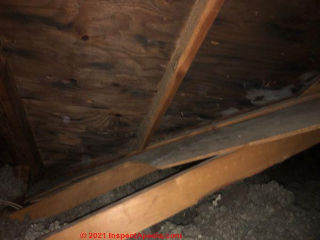
On 2021-04-08 by Lauren
@Anonymous, Does it appear dangerous?
On 2021-04-08 by (mod) - mold indicates improper under-roof ventilation under new roof
 @Lauren,
@Lauren,
Yes that's mold under your roof sheathing and possibly some water stains. Roof is replacing the roof don't normally replace unless it's rotted or mechanically damaged
Ifn your photo I see what it looks like a few small round holes drilled in the roof eaves. If that's true You certainly do not have sufficient intake ventilation
and you may not have adequate ridge outlet venting.
You will want to review the under roof ventilation system for which you will find detailed guidance at this website under the topic
of SOFFIT INTAKE VENT BLOCKED
Also read ROOF VENT SOFFIT + RIDGE NEEDED
Also read MOLD CLEANUP - WOOD FRAMING & PLYWOOD
On 2021-04-08 by Lauren
Hello, just wondering what type of mold this could be/ if it is mold. It's in the roof on the sheathing. [photo above]
Roof was replaced a year ago, but it looks like they didn't change out the plywood or there was a ventilation issue with the bathroom fans because they were recently replaced as well. This is our new house we are moving into. What sort of removal needs to happen? Thank you!
On 2021-04-02 - by (mod) - DIY mold cleanup for small job
@Ajohnson,
MOLD CLEANUP, DO IT YOURSELF
may be of some help
On 2021-04-02 by Ajohnson
thank you so much for your response! Do you have any suggestions for how to clean it myself? I tried lightly wiping it with bleach before (in a hard to reach area above a set of garage stairs), but it didn’t significantly change the way it looks. Thank you so much!
On 2021-04-02 - by (mod) - trivial mold stains - small cleanup
@Ajohnson, I can't see enough in your photo to be certain whether there's actual mold growth present or not but usually that black staining on what is a bold indicator when the plywood subfloor has been wet from leaks. It's likely that the leak continued for sometime before it was discovered which of course increases the probability of mold growth in that area.
Good news is that from your photo areas appear to be dark and perhaps moldy and wet are quite small, certainly less than 30 ft.² of continuous mall which would be the threshold at which you would hire a professional.
On 2021-04-02 by Ajohnson
Is this harmful mold, or perhaps just water staining? There was a leak here that’s been fixed some months ago. The lighter “fuzzy” looking patch right by the pipe is insulation poking through. Thank you for any insight!
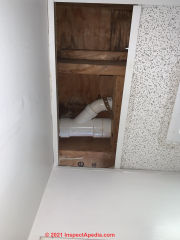
Is this dangerous mold, or maybe just water staining? There was a leak here that was fixed a few months ago.
On 2021-03-24 - by (mod) - is dormant mold in my attic a concern?
"Dormant" mold is not harmless; a dry spore can still be allergenic, pathogenic, toxic; and with such a huge inoculation of moldy material already present, you can expect it to become "not dormant" the next time there's attic moisture.
With that much moldy roof surface I would consider
1. the roof sheathing itself may be damaged and need repair or replacement
2. the insulation below may be contaminated
3. the drywall surface, attic side, below the insulation should also be inspected for mold contamination
and
4. What's that horizontal wire that looks like a large diameter aluminum wire?
On 2021-03-24 - by (mod) -
Re-posting from private email:
AUTHOR: Benjamin Roberts (no email)
COMMENT: In the attic of my cape home. Appears dry and dormant now? and when i discovered it in the past. Flaking in some spots , on the under side of the roof sheathing. Pic 1
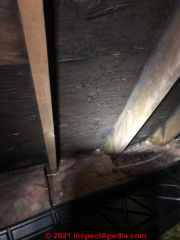
On 2021-03-03 - by (mod) - dealing with attic mold
@Jon,
MOLD CLEANUP - WOOD FRAMING & PLYWOOD
Has suggestions. I would clean the surfaces, not worry about remaining stains, fix the leaks or other moisture source such as inadequate ventilation, and optionally, maybe use a sealant on the wood surfaces.
On 2021-03-03 by Jon
Hi- Having a roof leak made me open up the ceiling drywall to inspect. I came across a portion of the plywood with mold. Planning on fixing the leak from the roof but deeply concerned about what to do with the mold. Any advice would be much appreciated.
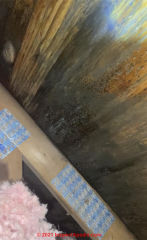
On 2021-02-11 - by (mod) - is this mold in the plaster or drywall wall?
Taylor,
Certainly there could be mold inside of drywall including that in your photo but frankly I can't tell from just the image. It looks to me as if the solid black paper may be the color of the paperback are used in the product.
I am very cautious about mold hidden in houses that have been flipped, having seen some in which a contractor bought a moldy house and simply had his crew laminate a layer of drywall over moldy surfaces throughout. My concern was that ultimately someone would move into the house and perhaps be asthmatic or immune impaired or have mold allergies and could have a reaction that would be hard to explain without some extensive investigation.
See MOLD APPEARANCE - WHAT MOLD LOOKS LIKE
On 2021-02-10 by Taylor
Hey there! We live in a home built in the 1970s. It was flipped. We recently found mold behind upstairs bathroom wall and baseboards. But during cleanup I also got paranoid and saw this - my stairs are peeling away from the wall and this is behind the trim. Is this mold or some kind of adhesive? Thank you!
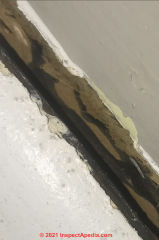
On 2021-02-07 by (mod) - is this weathered, moldy wood safe to use indoors?
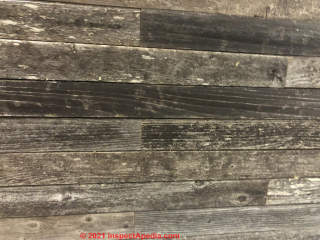 Most likely that blackening is a mold that, outdoors, would be harmless but indoors, even if it's simply a species of Cladosporium - the most-common outdoor mold genera, it may be at least allergenic.
Most likely that blackening is a mold that, outdoors, would be harmless but indoors, even if it's simply a species of Cladosporium - the most-common outdoor mold genera, it may be at least allergenic.
Sometimes a mold present on a surface is so happy it doesn't release significant levels of MVOCs nor spores until its environment changes. I watched very moldy books in a library go from releasing almost nothing into the air to releasing thick clouds of Aspergillus sp. spores within hours of turning on commercial dehumidifiers and air machines.
There area some options to try before a tear-out, depending on the urgency of the situation:
- if you ventilate the room with fresh air do symptoms diminish?
- do your symptoms go away when you are away from this home or room? (this is not definitive but can be diagnostic)
- are the boards installed over a drywall ceiling? (and are we sure there are no leaks above nor other obvious indoor air quality or contaminant sources?)
If so, one might consider the option of sealing the exposed surface with a low VOC polyurethane or similar clear sealant in a flat finish; that would substantially reduce offgassing and spore release.
On 2021-02-07 by Robert Nelsen
I built shop five years ago I used reclaimed fencing.some of the boards were blackened, don’t if it’s mold or not . [see photo above]
I used them on ceiling I have a bed room above ceiling.
Sleeped up their for a couple of months around that time I started to get consistent head aces boards looked the same now as when I put them up dry & in summer.
Dr can’t figure it out wife wants to do wall in house . Need to know if its safe
On 2021-02-01 by (mod) - is attic plywood mold harmful?
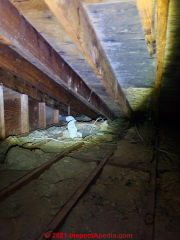 BK
BK
Many if not most indoor molds, except the two cosmetic ones illustrated above on this page, can be at least allergenic, and some are more -dangerous. Mold growing on the underside of your roof deck will include several species, not one of which can be identified from a photograph;
Common attic plywood molds are allergenic (such as species of Cladosporium and some other dark molds) and some potentially more-harmful if present, such as species of Aspergillus.
Such molds can also contaminate the insulation.
Just how much airborne mold moves from attic down into living area is not determined from a photo.
MOLD / ENVIRONMENTAL EXPERT, HIRE ?
can help you decide if you need an onsite expert inspection;
Cleanup options are discussed starting at
WOOD FRAMING & PLYWOOD MOLD CLEANUP
On 2021-02-01 by BKSage
is this s a harmful mold? [Photos below and just above - Ed.]
On 2020-11-27 - by (mod) -
Dane: It's likely that you're seeing the type of mold described on the page above.'
Notice that while there is dark coloured mold on the surface of the floor joist in your photo, does not extend over onto the surface of the wood flooring that is in contact with the joist.
That is a strong suggestion that the mold on the joists was not growing nor produced by conditions in the area where the joist is now found - as if it were, we'd expect the mold growing there to cover other similar wood surfaces in the very same location.
On 2020-11-27 by danemorgan
Found possible mold on floor framing in my basement. Is this dangerous? Any ideas on how this 'mold' got here? What should I do about it?

On 2020-11-04 - by (mod) -
That looks like it might be water stains or mold that came in on the lumber, certainly not growing on-site, as we don't see any of the black stains spreading over onto abutting wood materials.
I can't say for sure what that is from just that photo; if you take a paper towel and wipe across the black does it come off?
If you look at the black areas under magnification is it only a stain in the wood or can you see material on the wood surface?
Compare what you see with photos above on this page.
And compare what you see with these
articles
WOOD I-JOIST & TRUSS MOLD CONTAMINATION
PHOTOS OF MOLD ON WOOD SURFACES
And see MOLD CLEANUP - WOOD FRAMING & PLYWOOD
On 2020-11-04 by Anonymous
On 2020-11-04 by Brian
The attached are spots on beams that are located in my basement. Is this mold, dust, or something else? Any cause for concern or need to get inspected? On several beams within the basement.
On 2020-10-21 - by (mod) -
I would clean it with any household cleaner and then just for a bit of insurance when it's dry spray with any sealant or if you prefer a fungicidal sealant
On 2020-10-21 by Arthur
The vent from a bathroom fan is not securely attached to the roof decking, resulting in the pictured moisture problem (roof deck on right, insulation below at left). The inspector hypothesized that moist air has been escaping out the edges for years, possibly exacerbated by snow cover on the roof.
Obviously, the vent needs to be secured so that the cause is removed. After that, is it worth having the black areas tested and/or neutralized, or is it most likely to be a cosmetic black mold?
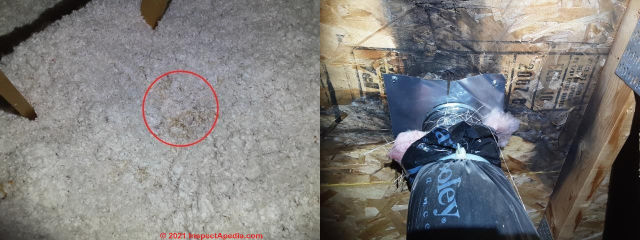
On 2020-08-11 - by (mod) -
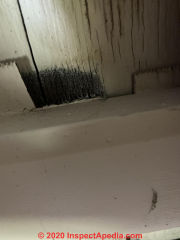 James
James
As there are what looks like a collection of water stains in the surrounding paint (on wood?) yes that could be mold
On 2020-08-11 by James B
Any idea if this is mold or something else?
The image is of an exposed old wood shakes that are functioning as a ceiling currently (underneath new shingles/underlayment)
On 2020-07-31 - by (mod) -
Chris, I agree that further investigation is needed to find the extent of rot and damage and of course the leak source.
This stain and rot are not simply from condensation or a vent problem; more-likely there was a prolonged leak nearby.
On 2020-07-30 by Chris
Looking at purchasing house I know it had a roof leak and is tarped right now also soffits are in bad too.
Attic has two big vents at either end and two attic fans but soffitfs only had a few small vents. main part of the attic looks fine but found this when a hole was punched in the ceiling near the outer wall. nothing showing on the outsdie of the dry wall.
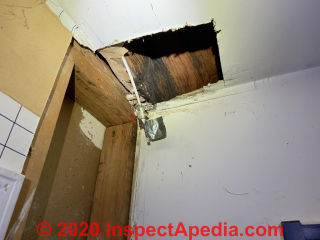
On 2020-07-26 by Cyn
Hello we went to put on a new sink and up of pulling that old platinum wall tile we found source of mold? Not sure if is black mold as we had no exterior signs no bubbles no smells nothing? So how do I tell the difference?
On 2020-07-21 - by (mod) -
"Construction mold" is not a term that I quite understand but we might speculate that what the inspector meant was
-mold that grew on wood during (or before its use in) construction
or
- mold that was already on the materials when brought to the job site
TO me that looks like dark mold on plywood that got wet.
The photo is too blurry to be diagnostic, but IF you see mold that did not grow over onto abutting wood surfaces then it may have been on the material at the time of construction.
Clean the surfaces and be sure there are no building leaks.
Please take a look at the more-detailed information above on this page and let me know if that leaves you with questions.
On 2020-07-21 by Scott
Suspected mold from a house that we are interested in buying is shown in the attached picture. Our inspector said that this looks like construction mold. The house is being sold by a relo company so they are doing an air quality test. Can you tell by the picture if this is "cosmetic mold" as you describe in your articles? I am thinking I should get a second opinion. This is in an unfinished part of the basement and I am concerned if there is more that is covered up in the finished areas.
Thanks for the help!
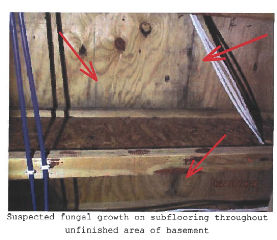
On 2020-06-24 - by (mod) -
Ak
If none of that mold extends up off of the wood framing lumber onto other wood that it touches - like subfloor OSB - it's probably pre-existing and reasonably likely to be what's described on the page above.
On 2020-06-21 by Al
Hello-These are from a house currently under construction. Based on info gleaned from your site it is non toxic mold. It appears to be sapstain. However your expert opinion would be appreciated. The contractor assures us that this is not toxic mold and the lumber came like this. The close up of the two large spots I wiped down with Tilex and just a little came off on a towel. Thank you,
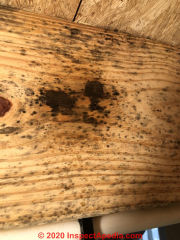
On 2020-04-01 - by (mod) -
Frank
You can bleach-spray but
- dead mold can still be toxic or harmful - containing, for example, mycotoxins
and keep in mind that
"toxic black mold" is a dangerous error in focus on mold hazards: most molds are not black and many of those are equally or more-harmful than the dark molds you see
and also that
outdoors you will have trouble preventing mold growth on wood surfaces that are shaded and damp or wet; improving ventilation under the deck can help as can cleaning the lumber (physically clean it off such as using a power washer and deck spray) and then when the lumber is dry, treat it with a penetrating wood preservative stain that's also water-repellent.
On 2020-03-31 by Frank
The treated lumber used to build our deck came with black mold, probably the harmless sapstain. But the underside of the deck has continued to mold heavily. We live in the woods and have had to our crawlspace remediated for several molds, including toxic black mold. It seems likely that we have toxic mold exploding on the underside of the deck. My inclination is to spray it with a bleach solution and then use some kind of encapsulant to keep it from coming back as the humidity is very high here. Is this the best solution?
On 2020-01-04 - by (mod) -
Pretty Blurry, Diane, and no text: so I can't comment usefully.
On 2020-01-04 by Diane Brogden
On 2019-12-17 by Camila
On 2019-12-17 by (mod) - don't confuse tile mastic adhesive for "black mold"
I can't say, Camilla; I don't see obvious mold but there could be some. What I do see that's black and shiny with parallel lines of tan looks like adhesive mastic.
The shiny black material is a mastic carpet glue.... Two different types.
Watch out: depending on the mastic adhesive age it may contain asbestos - not friable but don't make a dusty mess.
On 2019-12-17 00 by Camila
Is this potential mold under the carpet? The smell is definitely musty but the straight line is confusing me.
On 2019-11-26 by (mod) - black stains on insulation are probably not mold
I don't see mould, though i do see what looks like dust deposition from air leaks - perhaps from air bypass leaks into the wall or ceiling where this fiberglass insulation is found.
See INSULATION STAINS - AIR BYPASS LEAKS for details.
On 2019-11-26 by Rick
Hi .. I sent a pic of the backside of the insulation in the basement of the house I am renting..
It all looks like this .. Is it Black mold ?
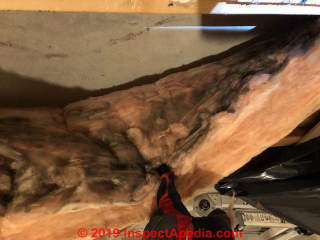
On 2019-08-09 by (mod) -
Thanks Jim, but you're not quite right.
The point of this specific article: Black COSMETIC mold, is that some molds on building surfaces are 100% harmless - "cosmetic" only.
It's usually easy to recognize these without testing - by visual inspection, as this article explains.
There is absolutely no need - no reason to "remediate" cosmetic or harmless mold unless it's for COSMETIC reasons such as ugliness on an exposed wood framed surface that's not going to be covered by finish materials.
A mold remediation contractor who sells a mold remediation job that is only addressing cosmetic mold is unethical and doing work that's inappropriate.
I agree, however that for other mold contamination, that is for harmful mold contamination (not the cosmetic case), there is almost no need whatsoever to test the mold to identify it's genera/species. Once we have eliminated the "cosmetic" mold case (which can be done without testing with a sole technical exception I'll skip for the moment), then knowing the mold genera/species will not change the cleanup procedure one iota.
So you don't need to test mold to remove it nor to fix its cause.
There are, however, some reasons to test a mold contamination to identify which genera/species are present (there will never be just one species). Examples include
1. in response to a doctor's request, wanting to know what dominant mold a sick person was exposed-to
2. as a control for a large costly mold remediation job, to be able to prove, after the job is claimed to be complete, that other building areas are or are not cross-contaminated by mold disturbed during the remediation process.
Those details are at MOLD TEST REASONS
Bottom line: there is usually no need to test mold. We agree.
On 2019-08-09 by Jim
@Steven Anderson,
Why would you tape sample what you already knew had mold on it? No value is gained from this. It needs remediated.
What is the point of sampling a surface when you’re going to remediate it either way? And who cares about speciating it. Treat it all the same - remove it when found.
On 2019-07-15 by (mod) -
Torula isnt a particularly hazardous mold, however it's virtually never the case that when mold growing conditions are present only a single mold species grows. It's more likely that because the Torula fungus on plywood is rather dark brown or maybe even looks black, so that that's where someone would have sampled. In other words there's probably other mold present. You need to find and fix the leak.
I think removing mold suspect insulation makes sense.
On 2019-07-14 2 by Steven Anderson
We have dark discoloration on plywood and fiberglass insulation in an unused space adjacent to bedrooms with a sloping roof making this area storage use only (15ft long 3feet wide and 5ft high).
I had a tape sample analyzed and it was determined to be torula mold. Is this a member of the cosmetic mold family? Your thoughts would be greatly appreciated. Thank you!
All the insulation has been removed using limited PPE items.
On 2018-11-28 by (mod) - large areas of mold deserve professional cleanup
Allison,
If there are large areas of contiguous mold indoors - more than 30 sq.ft. - then professional mold removal or "mold remediation" would be appropriate, along with steps to find and fix the leaks that invited mold growth in or on building materials.
See MOLD / ENVIRONMENTAL EXPERT, HIRE ? for help in deciding if an onsite expert is needed.
On 2018-11-28 by Allison
My mother resides in a 4 year old condominium building she is first owner. Water and some mold detected along wall area and she is now aware of 3 other units with water damage.
Trying to figure out next step ... request leak detection service or mold detection service? Please advise, thank you
On 2018-11-17 by (mod) - "we are very surprised to find mold in the box sills" - check for carpenter ants
Toniko
From the location and pattern of the mold on the OSB in your photo I doubt that the issue is a vapor barrier - more likely there was a leak into that spot, I'd inspect more-closely outside and above the moldy spot.
When back at my computer where I could get an enlarged look at your photo [click to enlarge any image on these pages] I saw what looks to me like carpenter ant frass - there may be a leak inviting ants into the structure.
That can happen in any home, new or old.
Check further for active carpenter ants - remove them, treating if necessary. Often removing the ants and fixing the leak that invited them into the structure is enough.
Clean off the debris, seal the surface, find and fix the leak - Before spray foaming insulation.
On 2018-11-16 by Toniko
Our home in Wisconsin was built in 2006; so we are very surprised to find mold in the box sills.
What would our next steps be? We have read that a vapor barrier should have been installed but somehow is not a required code in WI :( We plan to have the spray foam insulation put in but are assuming they would not be willing to spray it over this!
On 2018-10-08 by (mod) - possible mold (not mildew) on wet framing lumber: check nearby mold-friendly materials
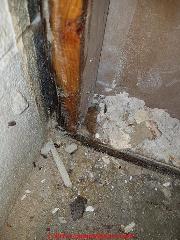 I would clean that cavity & the exposed services thoroughly and let it dry.
I would clean that cavity & the exposed services thoroughly and let it dry.
Check for mold growth on nearby drywall or other mold-friendly surfaces. If you find moldy drywall, remove it and simply toss it out as construction debris.
You might improve the durability of the repair by painting or spraying with a fungicidal sealant or with any lacquer primer sealer once the surfaces are dry before you put the wall back together.
You should remove suspect materials that have been wet along the bottom of the wall until you have found a clear margin free of any visible mold for one stud bay horizontally and 4 to feet above the highest point at which is all mold in the wall cavity vertically.
On 2018-10-08 by Eric
We just bought a new home a few months ago. We had some laminate flooring in the basement, some near the furnace we had to take up because the furnace backed up and leaked and water got under causing a lot of mildew to form.
After cleaning the area the smell was still strong so i inspected the walls/floor around the furnace and found the corner wall up against the outside wall was looking funny so I tore the drywall out in that area.
The picture is what I found. Pulled the 2x4 away from the outside wall and noticed black on both the 2x4 and outside wall. Mold to worry about?
On 2018-10-07 by (mod) - Cosmetic mold and mold-stains from subsequent lumber wetting
Ariel in your photos I see what looks like typical cosmetic mold found on some framing lumber. More examples are at BLACK MOLD, HARMLESS.
In your second photo of black stains on studs in your home under construction, I suspect that the lumber, already moldy, got wet, perhaps in rain, causing some rundown stains on the wood while still stacked flat.
I'd start by reviewing the cosmetic mold distinctions made in the article I cite above.
On 2018-10-06 by Ariel
The builder told us this was water stains but I'm confident that it is mold should we higher a mold inspector to prove that its mold so the builders will treat it I'm very concerned
We are getting a home built and I notice black mold on the framed lumber should we get thos treated
On 2018-09-14 by (mod) - cleanup advice for a moldy plywood step surface indoors
Brian
The photo (above) is not quite clear but that does look like mold growth, perhaps from having been wet with whatever was spilled.
If you can wipe it off or clean it off with any household cleaner, and provided there's not more of the same crud, it's a "clean and forget" problem.
Or if it's making you worry, after the landing is clean and dry paint it with a lacquer primer sealer.
On 2018-09-14 by BrianCarr
We had pulled up our laminate flooring and on the subfloors (specifically a few steps), we found these black speckles. I’m not if this is just something that was spilled on the subfloors years ago or is some type of cosmetic or black mold but would love any insight. Thanks!
On 2018-04-20 by (mod) - signs of a wet crawl space risk hidden mold
"Alarmed" might be stronger than necessary, Jose.
I see signs of water outside the foundation wall, questionable white tubing that might be improper handling of drainage from something, perhaps air conditioners?,
a white tube that might be improperly dumping condenate or other drainage into a crawl area, and with wet conditions there a risk of a mold contamination issue to be cleanedpup.
Depending on where you live, the crawl space ventilation design could be a bad idea. More extensive inspection would be appropriate.
Watch out: when a crawl area has been wet you should also consider that the insulation may be moldy, and wood framing and subfloor hidden by insulation could be moldy. .
Further investigation would be appropriate.
See the advice given at CRAWL SPACE DRYOUT - home
On 2018-04-20 by Jose Romero
I’m in the process of selling my house and found this in the garage and crawl space
Should I be alarmed?
Jose
On 2018-04-11 by (mod) - don't mistake knots in framing lumber for mold - but yes, the photo shows "cosmetic" damage to a stud
Paul that looks like a knot in wood 2x framing lumber.
On 2018-04-11 by Paul Dominic Alonso Galang
Is this cosmetic or something else?
On 2018-04-06 by (mod) - professional cleanup needed if more than 30 sq.ft. of non-cosmetic mold
Patty
You can use the picture frame icon to the right of the comment button below to attach a photo 1 / comment and that might let us see better what's going on.
Shortly if you think a main support beam is deteriorated you should have a professional evaluate the repair that's needed.
If there's more than 30 square feet of continuous mold mold cleanup needs to be done professionally as well at this website you'll find articles on how to clean up mold including using Media Blasting that might be appropriate in a crawl area as well as steps for crawl space dry out both of which are going to be needed.
On 2018-04-06 by slinkerpatty
We have recently found alot of mold under our house in the crawl space. Water has been coming in for a long while apparently bc our bedroom floors dropped.
The Main beam has deteriorated.
We have black and white mold and alot of it. Should I get a professional to check this? I have pictures
On 2018-04-05 by (mod) - Cosmetic black mold on framing in an Arizona home
Cosmetic mold photo provided by an Arizona reader SW by private email 2018/04/05
On 2017-03-31 by (mod) - mold growth in a Raleigh area crawl space
I agree that mold growth in a Raleigh area crawl space would be quite common. If the total area of visible mold is less than 30 square feet, ordinary cleaning would ordinarily be sufficient.
If there's a large area of non-cosmetic mold it would make sense to clean that and to repair your plastic Vapor Barrier on the crawlspace floor. Listen for that sort of advice from a contractor.
On 2017-03-31 20:03:57.073426 by Andrew Flanagan
We also have a dilemma regarding mold in our crawl-space.
An inspector identified fungus growths without any reference to the seriousness of the growth. As a result the buyers of our house are very nervous and would like to have a inspection/remediation. Some of the growth does look like cosmetic mold given that you can see the break in the mold line. In a few other areas there is dry dust-like growth.
Our crawl-space has never had a leak nor water damage.
We're in North Carolina (Raleigh area), so we expect this is a case where our vented crawl-space is affected by the high humidity in the summer months.
The vapor barrier has been crumpled up by trades over the years as well and should probably be replaced. While we don't think remediation is necessary, the buyers would like to investigate further.
Most of the contractors we have contacted have noted that if they see mold present they will recommend cleaning it.
How can we arrange a reputable or unbiased inspection/assessment to ensure we are taking the right steps without taking unnecessary action. Thanks very much for your help
On 2017-01-19 by avalon2sunset - Should I scrape off samples of the mold where it had spread to other boards
It was brought to my attention by an environmental service rep, while providing me with an estimate for a sump pump installation in the crawlspace of my house, that several of the floor joists are infected with black mold. He indicated that it would be prudent to remove all insulation between joists and have complete mold treatment on all joists (including those with no mold).
Since the estimate for this work was quite expensive ($5,000 for 1400 soft), I did some research on this site before going back under the house and inspected all wood with mold.
To my surprise, mold present on most of the joists had not spread to adjacent wood.
However, I did notice that there were several joists along the wall interface to exterior of crawlspace where mold had spread to adjacent wood (is this due to moister conditions along exterior wall?)
Should I scrape off samples of the mold where it had spread to other boards and send in for lab analysis, or is it safe to assume that they are not strains that are a health hazard? If remedial treatment is recommended, would tree tea oil be the preferred application? And I'm assuming that remedial mold removal only where there is evidence of spreading would suffice, is this correct?
On 2016-10-12 by Kevin
I just removed my old broken dishwasher to find a black spot underneath of where the water supply is located. What is the best way to remediate before reinstalling the new dishwasher. Can this be cleaned and then sealed with a primer?
On 2016-10-09 by (mod)
Anna levis said:
There are different natural ways to remove black mold completely so that it will never reappear again and also the removing process needs to be properly done so the mold will never reappear again and again. You can use vinegar, baking soda and hydrogen peroxide as these are some great solutions to remove black mold. This article will definitely help you and also guide you the steps for black mold removal.
On 2016-06-19 by (mod)
Karole:
Indeed it's common to find both cosmetic (harmless) molds on treated lumber and other framing lumber, coming in from the lumber yard, and sometimes mixed-in with it can be more harmful molds that are growing actively if the lumber was left exposed to weather or wet.
On treated wood I've found species of both Aspergillus and Penicillium growing along with older unimportant dark cosmetic molds.
If the wood is being used outdoors you won't care; if it's being used indoors you want it to be cleaned and dry before installation if there's any worry about ongoing or active fungal growth.
While microscopic examination by an expert is needed to identify fungal genera/species, you might get a clue by simple magnified view yourself: look for obvious gray or green mold growth on the wood, and look for mold growing across saw cuts as we describe in this article series as that tells us it's not old, pre-existing.
On 2016-06-19 by Karole
Hi. I found your site looking for information on cosmetic black mold. Thanks for the information. I found info on pressure-treated lumber that came with cosmetic mold from the lumber yard, but my builder dropped floor joists on the ground before they could pour the slab, and they sat on wet ground through seven weeks of rain.
There is mold on several of them, and I have no way of knowing if it was there when the joists were delivered, or if it developed from the wet ground conditions. The house will eventually be sheet rocked.
Of course, he is assuring me that it's cosmetic. I'm not so sure. Thanks for your help.
This comment was posted originally
On 2016-05-24 by Krista
We are selling our house and the inspector found mold in the attic. When we bought the house, the mold was there, but at the time referred to as "mildew". The previous home owner had the bathroom vented into the attic. We fixed the vent and installed and attic vent fan. The photos the inspector took don't look the mold has increased at all from when we fixed the venting issue. Does the mold need to be removed by a professional? Or since we removed the source of moisture is it essentially dead and now just stains? We've lived in the home for 10 years.
Question:
(July 10, 2014) Kimberley said:
Hi, we are looking at buying a house that the inspector found mold in the crawlspace.
There is water intrusion and a fair bit of blackish looking mold on the sill plates. Would you be willing to look at a few pictures to see what you think? How could I send them to you?
Reply:
Kimberly,
You can use our CONTACT link at page bottom or top to send us photos.
But certainly as you had an onsite expert that person ought to help you understand the situation, including extent of cleanup needed and the cause of mold growth that needs to be fixed, and the level of risk of other less obvious leaks or mold or other possibly costly issues.
Thus you can get a more accurate idea of the total cost of the home and plan accordingly.
...
Continue reading at BLACK MOLD, HARMLESS or select a topic from the closely-related articles below, or see the complete ARTICLE INDEX.
Or see these
Recommended Articles
- COSMETIC MOLD, RECOGNIZE
- BLACK MOLD, TOXIC & ALLERGENIC
- The distinction between harmful and harmless mold in attics or under roofs is discussed further at ATTIC MOLD, HARMLESS COSMETIC?
- COSMETIC MOLD CLEANUP EXPENSE
- MOLD APPEARANCE - WHAT MOLD LOOKS LIKE
- MOLD CONTAMINATION IN BUILDINGS - home
Suggested citation for this web page
BLACK MOLD, HARMLESS, FAQs at InspectApedia.com - online encyclopedia of building & environmental inspection, testing, diagnosis, repair, & problem prevention advice.
Or see this
INDEX to RELATED ARTICLES: ARTICLE INDEX to MOLD CONTAMINATION & REMEDIATION
Or use the SEARCH BOX found below to Ask a Question or Search InspectApedia
Ask a Question or Search InspectApedia
Questions & answers or comments about cosmetic black or dark colored mold in buildings.
Try the search box just below, or if you prefer, post a question or comment in the Comments box below and we will respond promptly.
Search the InspectApedia website
Note: appearance of your Comment below may be delayed: if your comment contains an image, photograph, web link, or text that looks to the software as if it might be a web link, your posting will appear after it has been approved by a moderator. Apologies for the delay.
Only one image can be added per comment but you can post as many comments, and therefore images, as you like.
You will not receive a notification when a response to your question has been posted.
Please bookmark this page to make it easy for you to check back for our response.
IF above you see "Comment Form is loading comments..." then COMMENT BOX - countable.ca / bawkbox.com IS NOT WORKING.
In any case you are welcome to send an email directly to us at InspectApedia.com at editor@inspectApedia.com
We'll reply to you directly. Please help us help you by noting, in your email, the URL of the InspectApedia page where you wanted to comment.
Citations & References
In addition to any citations in the article above, a full list is available on request.
- [1] Ceratocystis and Ophistoma, Taxonomy, Ecology, and Pathogenicity, MJ Wingfield, KA Seifert, JF Webber Eds., APS Press 1993, ISBN 0-89054-156-6
- Hanlin, Richard T. 1998. Illustrated Genera of Ascomycetes. Vol. II. APS Press, St. Paul. 238 pp.
- [2] Schmidt, O. and D. Czeschlik. 2006. Wood and Tree Fungi. Springer, Secaucus. 336 pp.
- [3] Lieutier, F., K. R. Day, J.-C. Gregoire, A. Battisti and H.F. Evans. (Eds.) 2004. Bark and Wood Boring Insects in Living Trees in Europe, A Synthesis. Springer, Secaucus. 569 pp.
- [4] Alexopolous, C.J., C.W. Mims, M. Blackwell. 1996. Introductory Mycology, 4th ed. (or later) John Wiley & Sons, New York. 869pp.
- [5] Forestry and Agricultural Biotechnology Institute: Ophiostomatoid Fungi: Expanding Frontiers
- [6] "Lumberyard Mold and Sap Stain", Francina Thadigiri, EMLab P&K Analyst, Environmental Reporter (email newsletter), Vol. 7 No. 5, June 2009
- [7] Fifth Kingdom, Bryce Kendrick, ISBN13: 9781585100224, - we recommend the CD-ROM version of this book. This 3rd/edition is a compact but comprehensive encyclopedia of all things mycological. Every aspect of the fungi, from aflatoxin to zppspores, with an accessible blend of verve and wit. The 24 chapters are filled with up-to-date information of classification, yeast, lichens, spore dispersal, allergies, ecology, genetics, plant pathology, predatory fungi, biological control, mutualistic symbioses with animals and plants, fungi as food, food spoilage and mycotoxins.
- [8] Fungi From Utility Poles in the Eastern United States, Identification Manual for, CJK Wang & RA Zabel Ed., Allen Press, 1990, ISBN 0-93-0009-31-2
- [9] Pictorial Atlas of Soil and Seed Fungi, , 2nd Ed., Tsuneo Watanabe, 2002 CRC Press, ISBN 0-8493-1118-7
- [10] Fungus, The Whole, Vol. 1, Bryce Kendrick, Ed., National Museum of Natural Sciences (et als), 1979, ISBN 0-660-00146-2 (available from B. Kendrick, Waterloo, Canada)
- [11] Fungus, The Whole, Vol. 2, Bryce Kendrick,Ed., National Museum of Natural Sciences (et als), 1979, ISBN 0-660-00146-2 (available from B. Kendrick, Waterloo, Canada)
- [12] Fusarium, Paul E. Nelson Memorial Symposium, Summerall et als. Ed., APS Press 2001, ISBN 0-89054-268-6
- [13] Hyphomycetes their perfect and imperfect connexions, K. Tubaki, J Cramer 1981, ISBN 3-7682-1267-X
- [14] Dematiaceous Hyphomycetes, , M.B. Ellis, CAB International 1971, ISBN 0-85198-027-8, Commonwealth Mycological Institute, Kew, Surrey, England, ABE-Print.com
- [15] More Dematiaceous Hyphomycetes, M.B. Ellis, CAB International 1976, ISBN 0-85198-3650-, Commonwealth Mycological Institute, Kew, w:st="on">Surrey, England
- [16] Illustrated Genera of Imperfect Fungi, 4th Ed., HL Barnett & Barry B. Hunter, American Phytopathological Society Press, St. Paul, 1998, ISBN 0-89054-192-2
- [17] Microfungi on Miscellaneous Substrates, Martin B. Ellis & J.Pamela Ellis, Crook Helm, London & Sydney 1988, ISBN 0-88192-115-7
- [18] Fungi, Identifying Filamentous, A Clinical Laboratory Handbook, Guy St-Germain, Richard Summerbell, Star Publishing, 1996, ISBN 0-89863-177-7 (English)
- [19] "Causes and Cures for Stains In Dried Lumber - How to avoid various types of staining in kiln-dried lumber. 1998.", WWOODWEB, web search 5/1/12, origial source: woodweb.com/knowledge_base/Causes_and_Cures_for_Stains_In_Dried_Lumber.html
- MOLD ATLAS & PARTICLES INDEX, Pathogens, Allergens and Other Indoor Particles - actual and possible medical health effects of Mold (separate online document)
- MOLD APPEARANCE - WHAT MOLD LOOKS LIKE Photos of what mold looks like in buildings, organized by mold color and appearance.
- MOLD FREQUENCY in BUILDINGS Table of what mold genera/species are frequently found in indoor mold tests.
- MOLD GROWTH ON SURFACES, PHOTOS Photos of what mold looks like in buildings, organized by mold growth on various kinds of building surfaces and contents or items found in buildings. Mold in situ.
MOLD GROWTH on SURFACES, TABLE OF, Summary table of what mold genera/species are frequently found on various building surfaces and materials - MOLD APPEARANCE - STUFF THAT IS NOT MOLD Photos of material that is not mold but is sometimes mistaken for mold
- Recognize Harmless Black Mold Photos of of often recognizable, usually harmless or cosmetic black mold on wood
- MOLD BY MICROSCOPE Mold under the microscope - photo identification of the most common indoor molds found in buildings
- In addition to citations & references found in this article, see the research citations given at the end of the related articles found at our suggested
CONTINUE READING or RECOMMENDED ARTICLES.
- Carson, Dunlop & Associates Ltd., 120 Carlton Street Suite 407, Toronto ON M5A 4K2. Tel: (416) 964-9415 1-800-268-7070 Email: info@carsondunlop.com. Alan Carson is a past president of ASHI, the American Society of Home Inspectors.
Thanks to Alan Carson and Bob Dunlop, for permission for InspectAPedia to use text excerpts from The HOME REFERENCE BOOK - the Encyclopedia of Homes and to use illustrations from The ILLUSTRATED HOME .
Carson Dunlop Associates provides extensive home inspection education and report writing material. In gratitude we provide links to tsome Carson Dunlop Associates products and services.


